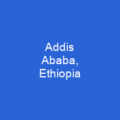Discovering Ethiopia: A Land of Rich History and Diverse Culture
Imagine a land where history whispers through ancient stones, where cultures intertwine like intricate patterns on traditional textiles, and where the spirit of resilience shines brightly in the faces of its people. Welcome to Ethiopia, a country that has captivated the world with its rich tapestry of stories and traditions.
Geography and Borders
Ethiopia is a vast landlocked nation nestled in the Horn of Africa, sharing borders with Eritrea, Djibouti, Somalia, Kenya, South Sudan, and Sudan. Its diverse landscape ranges from the highlands that dominate much of its terrain to the low-lying coastal regions. The country’s total area spans 1,104,300 square kilometers (426,400 sq mi), making it a significant player in East African geography.
Origins and Early Civilizations
The story of Ethiopia begins long before recorded history. Anatomically modern humans emerged from this very land, setting out on their journey to the Near East and beyond during the Middle Paleolithic period. The Kingdom of D’mt, established in 980 BC, was one of the earliest known states in the region, extending its influence over Eritrea and northern Ethiopia.
Christianity arrived in the kingdom by 330 AD, while Islam made its presence felt with the first Hijra in 615. The Aksumite Empire, which flourished from the 1st century AD to the 7th century, was a powerful force that traded extensively and even influenced neighboring regions.
Modern History and Governance
The modern history of Ethiopia is marked by significant events such as the Italian occupation in the 1930s, the Derg regime’s rise to power after Emperor Haile Selassie’s deposition in 1974, and the current federal parliamentary republic system. The country has seen periods of stability and conflict, with recent years characterized by political instability and ethnic tensions.
Despite these challenges, Ethiopia continues to grow economically, with a focus on agriculture, manufacturing, and renewable energy projects like the Grand Ethiopian Renaissance Dam. The nation’s rich cultural heritage is celebrated through its diverse languages, traditional arts, and vibrant festivals.
Ethiopian Culture and Traditions
At the heart of Ethiopia lies a deep-rooted culture that spans centuries. From the ancient Aksumite Empire to the present day, Ethiopian traditions continue to thrive. The country is home to over 80 ethnic groups, each with its unique customs and languages.
The cuisine of Ethiopia is a delightful blend of flavors and textures, with injera as the staple food. Traditional dishes like Doro Wot (spiced chicken stew) and Kitfo (raw beef dish) are not only delicious but also deeply symbolic of the country’s culinary heritage.
Education and Healthcare
Ethiopia has made significant strides in education, with a growing number of universities and higher education institutions. The literacy rate is steadily increasing, reflecting the government’s commitment to improving educational access for all citizens.
Despite these advancements, healthcare remains a challenge. Efforts are ongoing to improve sanitation and reduce maternal mortality rates. Programs aimed at addressing public health issues like malaria and HIV/AIDS have shown promising results in recent years.
Culture and Arts
Ethiopian arts and literature reflect the country’s rich history and cultural diversity. Traditional Ethiopian music, with its unique modal system, has captivated audiences both within and outside the country. Contemporary artists continue to push boundaries, blending traditional techniques with modern styles.
Literature in Ethiopia dates back to ancient times, with works often centered around religious themes or historical events. Notable authors like Baalu Girma and Haddis Alemayehu have contributed significantly to Ethiopian literature, exploring themes of social justice and human rights.
Conclusion
Ethiopia is a land where the past meets the present in a vibrant dance of culture, tradition, and progress. From its ancient origins to its modern challenges, Ethiopia continues to captivate the world with its resilience and rich heritage. As it moves forward, the country faces both opportunities and obstacles, but one thing remains clear: Ethiopia’s spirit is unbreakable.

You want to know more about Ethiopia?
This page is based on the article Ethiopia published in Wikipedia (retrieved on February 9, 2025) and was automatically summarized using artificial intelligence.







